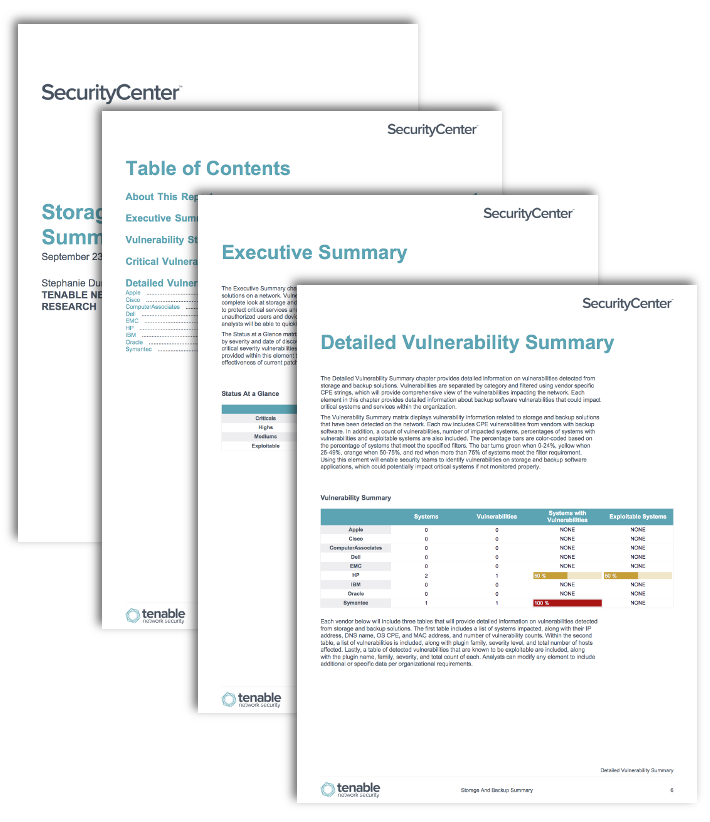by Stephanie Dunn
October 6, 2016

Organizations rely heavily on storage and backup solutions to retain and protect critical data from compromise. These services provide organizations with abilities to encrypt, backup, and restore confidential data for disaster recovery and compliance purposes. However, they can also be subject to exploitation and leave critical data at risk if left unmanaged. This report presents the latest information on known storage and backup vulnerabilities from products such as ComputerAssociates ARCserve, EMC NetWorker, and Symantec BackupExec.
Most organizations employ some type of backup solution to store critical data within their environment. These services can utilize a combination of tape, disk, and cloud backup solutions to access, retrieve, store, and encrypt data. This report leverages data collected from Tenable Nessus, and provides a comprehensive look at vulnerabilities detected on storage and backup solutions throughout the enterprise.
This report uses the Common Platform Enumeration (CPE) filter to identify many of the software programs used in enterprise networks. According to NIST, the CPE is a structured naming scheme for information technology systems, software, and packages. Based upon the generic syntax for Uniform Resource Identifiers (URI), CPE includes a formal name format, a method for checking names against a system, and a description format for binding text and tests to a name. Tenable assigns CPEs to plugins where appropriate. This allows for analysts to search for common CPE prefixes such as “cpe:/a:ca:arcserve,” “cpe:/a:dell:equallogic,” and “cpe:/a:symantec:backup_exec.” Associating CPE strings with vulnerabilities allows the analysts a greater view into separating operating system vulnerabilities from application vulnerabilities, and adds to the level of vulnerability detail provided to the organization.
Data presented within this report is gathered by active vulnerability scanning with Nessus and passive vulnerability detection with Tenable Passive Vulnerability Scanner (PVS). Using this data, security teams will gain valuable insight into existing vulnerabilities on storage and backup solutions across the enterprise. An overview of vulnerabilities from each vendor will provide detailed information on vulnerable hosts. Organizations will be presented with a summary of vulnerabilities detected over time, including exploitable vulnerabilities, which can aid security teams in prioritizing remediation efforts. This data can be useful in understanding and mitigating potential threat vectors, and securing backup solutions within the organization.
This report is available in the SecurityCenter Feed, a comprehensive collection of dashboards, reports, Assurance Report Cards, and assets. The report can be easily located in the SecurityCenter Feed under the category Threat Detection & Vulnerability Assessments. The report requirements are:
- SecurityCenter 5.3.1
- Nessus 6.8.1
- PVS 5.1.0
Tenable SecurityCenter provides continuous network monitoring, vulnerability identification, and security monitoring. SecurityCenter is continuously updated with information about advanced threats and zero-day vulnerabilities, and new types of regulatory compliance configuration audit files. Tenable constantly analyzes information from our unique sensors, delivering continuous visibility and critical context, enabling decisive action that transforms your security program from reactive to proactive. Active scanning examines storage and backup software applications on systems, running processes and services, detection of vulnerable software applications, configuration settings, and additional vulnerabilities. Monitoring the network to ensure that all systems are secured against vulnerabilities is essential to ongoing security efforts. Tenable’s extensive network monitoring capabilities enables a powerful, yet non-disruptive, continuous monitoring of the organization to ensure the latest vulnerability information is provided to analysts.
The following chapters are included in this report:
- Executive Summary: The Executive Summary chapter provides a high-level overview of vulnerabilities from storage and backup solutions on a network. Vulnerabilities are tracked by severity, vendor, and time in order to provide a complete look at storage and backup software applications that may be at risk. These services help to protect critical services and infrastructure within an organization, and help to detect and prevent unauthorized users and devices from connecting to internal resources. Using the elements within this report, analysts will be able to quickly identify, remediate, and reduce overall security risks.
- Vulnerability Status at a Glance: The Vulnerability Status at a Glance chapter provides insight into vulnerabilities detected from storage and backup solutions within the network. Each table included within this chapter provides lists of the backup software vulnerabilities detected in the past 7 and 30 days. Each table presents the latest information on relevant vulnerabilities, including plugin, name, family, severity, and total count of vulnerabilities detected. Data presented within this chapter can be modified to include additional host information, and additional details on the detected vulnerability.
- Critical Vulnerability Information: The Critical Vulnerability Information chapter presents a table of the top critical vulnerabilities detected from storage and backup solutions in the enterprise. Vulnerabilities with a critical severity level are presented and filtered using vendor specific CPE strings, which will highlight vulnerabilities that present the highest level of risk to the organization. Each table is sorted by severity, and includes the plugin name and total number of hosts affected. Using elements within this chapter, security teams can use this element to target and remediate vulnerabilities on systems using backup applications and services.
- Detailed Vulnerability Summary: The Detailed Vulnerability Summary chapter provides detailed information on vulnerabilities detected from storage and backup solutions. Vulnerabilities are separated by category and filtered using vendor specific CPE strings, which will provide a comprehensive view of the vulnerabilities impacting the network. Each element in this chapter provides detailed information about backup software vulnerabilities that could impact critical systems and services within the organization.